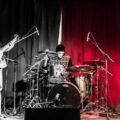Most modern recording sessions don’t take place in big budget studios like they once did. These days, there are hardly any limitations in terms of space, compared to when consumer recording interfaces first hit the market. CPU processing and plugin algorithms have come a long way in a short amount of time. We have access to some incredibly vibrant reverbs, colorful compressors, and amazingly well-emulated outboard gear in our computers now. Where once there was a love of recording drums in a great sounding huge room, now tastes might change to recording drums in as dry and tight a manner as possible by dampening and diffusing the room that’s being working in. This method can help you decide how big the room sound comes across in the final mix when everything else is tracked. Let’s take a moment to discuss how we can get that final room sound with a chain of plugins.
Recording the Right Source Material
Even though you’ll be dialing up your huge room sound with plugins, you need to make absolutely certain that you’ve recorded the right source material to feed to this software. Oftentimes, the most important tracks to capture from the drum kit on recording day are the overheads and room positions. You can always meticulously program in some direct trigger sounds if necessary, but you absolutely need to capture the kit as a whole with the mics if you expect to get something versatile to work with in the mix.
An option can be to work with stereo positions for these angles, but it’s even more important to set up the mics so they are capturing all elements of the kit as balanced as possible before using compression (even when confined to mono positions). This means coming in from a bit of an angle over the player’s shoulder when placing overhead mics above the kit at times. Other times, the mics are centered and lifted a bit higher than they would normally be. It’s important to keep in mind that each player has a slightly different sweet spot.
Even if you’re not recording in a very flattering space, it’s still very important that the room mic position is capturing the space more than the drum kit itself. This is why it’s important to treat the room as much as possible without breaking the bank. Instead of trying to set up your session in a great-sounding room, consider minimizing the less flattering aspects of the room you’re already using. Again, make your priority the goal of capturing a good balance as the individual elements of the kit spill into the room. Be sure to check for this before hitting record. For example, if the kick or a crash cymbal seems absurdly loud compared to the other elements, you should reposition the mic.
Working in Parallel
You’re going to want to feed these overhead and room positions to a separate auxiliary channel in post mode. Don’t send any direct channels to this parallel aux channel if you recorded them during the recording session. You want to work with the carefully balanced overhead and room channels that you so diligently managed during the tracking session.
It’s incredibly important that you have your session setup so that you can change the fader level of your processed auxiliary channel separate from the raw microphone recordings. While you’re going to generate the sound of a large pro studio environment with plugins, you need to make sure you’re always keeping it in perspective with the actual recording of the kit. You need to work hard at making sure that this big space you create doesn’t seem to stick out like a sore thumb and sound like a bunch of effects. You may find yourself changing the fader level as you tweak plugins and working in parallel makes this easily manageable.
Starting the Chain with Some Colourful EQ
You’re going to want to use an EQ or two in order to focus this parallel channel on the extreme ends of the frequency spectrum (highlighting the sparkly highs and big lows). It’s important to start with this step so that you can clean things up and feed the most important aspects of your recording to the reverb and compressors that will come next. It’s okay to get a bit aggressive with some of these EQ moves since this channel is working in tandem with the original unprocessed channels. Because of this, you can find yourself reach for an EQ that emulates a colourful analog unit. Many plugin companies such as UAD, Slate Digital, and Waves offer emulations of Neve, SSL, API, and more. These EQs add a bit of harmonic saturation and phase tilt as you turn the knobs, romanticizing and manipulating the effect of their curves more so than a transparent EQ will.
An option is to focus on boosting the lowest and highest frequencies with shelf EQs at 100hz and 10khz. Next, using 2 or 3 parametric knobs to hone in on boosting the high mids (usually around 2khz-5khz) as well as cutting the low mids (usually around 400Hz-800Hz). Again, it’s important to remember that you should be referencing the way things sound while considering how both the original and parallel processed channels sound together. The processing may seem too extreme if the parallel channel is in solo. Be sure to listen to the big picture and consider the fader level of the aux channel as you tweak the EQs.
Adding Reverb to the Process
Now the channel will be ready for a reverb plugin after all that focusing. It’s important that you choose a reverb sound that isn’t too “over the top”. While you were aggressive with your EQ sounds, you’re going to want to be a little more conservative with the length of your reverb tails. Try to pick a more acoustical sounding reverb that emulates a room sound with a tail of 300ms to 1 second in length. This usually results in a more authentic room sound that we can “sneak” into the mix with the fader level of the parallel channel more so than a mechanical reverb such as plate or spring can get away with. That being said, there are no hard set rules. If the song you’re creating is going for a dreamy, surreal or over the top aesthetic, then go for it! Just remember to keep the vision of the entire mix in perspective with this artificial space that you’re creating.
Keeping the Artificial Room Consistent
The final icing on the cake for your plugin chain comes in the form of 2 very particular compression processes. You want to take the sound that you’ve created in parallel and go out of your way to remove much of the dynamics from it. Your original unprocessed channels will give the impression of dynamics while your parallel channels keeps the impression of the room we’ve created on a consistent basis.
You can start with a colourful compressor. There are some very important settings to keep in mind while setting this compressor. You’ll want to use a compressor with a high pass filter option so it doesn’t react to the big lows that we dialed in earlier. This unit should be reacting to the higher frequencies more than anything. Use a midrange ratio to accomplish this, somewhere from 5:1 to 10:1. You want to let the initial attack of the drums through more than anything, so use a medium attack setting along with a very fast and aggressive release time. This is why it’s important that you get a good balance on your microphones during tracking day.
The real trick to this approach is finalizing the chain with a de-esser since we’ve boosted your highs so much with EQ. Sure, the high pass filter on the first compressor avoided responding to the low-end, but now you want to control specifically the high frequencies separately. A lot of students often ask why they should bother boosting high frequencies early on if we’re just going to compress them later. Remember that de-esser is doing more than just turning the highs back down. Instead, it is setting those high frequencies to a consistent volume that you can then dial in as a careful final level with the auxiliary channel’s fader. This is so much more productive than having cymbals that are difficult to set in the mix because they’re jumping around in volume so often.
—Final notes—
Modern technology now gives us the ability to create the exact space we’re looking for if we diligently control the less flattering aspects of the space we’re recording in. You might even find yourself constantly taking this plugin approach these days, rather than hunting for a great sounding space and hauling all of the gear into it. Even when working in some great studios, the room sound for the drums isn’t always all that riveting. An option would be to erect a bit of acoustical treatment in a makeshift room or setup the drums in an isolation booth so that more time can be devoted to discussing the overall aesthetic the band is looking for. Why not sculpt this vision in the computer, where the final mix will be taking place anyways? Drums excite the reverb in a room more so than any other instrument – don’t find yourself stuck with a sound that doesn’t lend itself to the band’s vision because you were stuck with a weak space on tracking day.





















